ABSTRACT
In recent years, although Vietnam rice has ranked 2nd in export in international arena, the rice quality is still low. Majority of rice export is of low quality and without recognized brands, which has led to a lower price in comparison with that of Thailand and India. The main cause is explained by the production habits of farmers in the country. Farmers were encouraged to slowly change from low-quality varieties to better ones, butlow-productive varieties as IR50404 are still in large proportion. Beside, the export standards which were issued long time ago, are now no longer suitable. Using too much pesticides in cultivation also makes Vietnam rice difficult to reach premium markets as USA and Japan. For example: in 2016, many shipments to the United States were rejected and returned because of chemical contamination.
Vietnam rice export quality
According to the Ministry of Agriculture and Rural Development, in 2016, the total rice export was about 4.54 million tons, equivalent to US$2 billion, down 25% in volume and 20.3% in value in comparison with those of 2015. The main difficulties came from the fact that China has tightened the control over rice exports and imports across the northern borders.
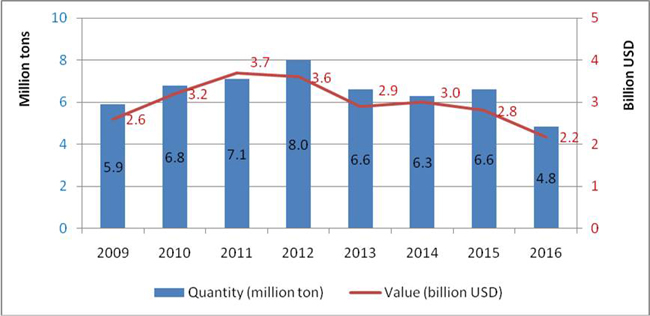
Fig. 1. Changes in rice export value from 2009 to 2016
Source: General department of Vietnam Customs
Export rice by types
In 2016, major types of rice export were white rice with 5%-25% broken rate (accounted for 70% of total export volume). Aromatic rice accounted for a quarter of total export rice volume, including Jasmine 85, SocTrang, Nang Hoa, Huong Lai, KDM, VD 20. Among the aromatic rice varieties, Jasmine was the largest product.
In 2016, 25% broken rice has decreased significantly, accounting for only 5% in total rice export, and the export proportion of 25% broken white rice has increased in comparison with that of 2015, reaching 16% in total export share. The proportion of sticky rice was little and mostly exported to China market at the end of the year.
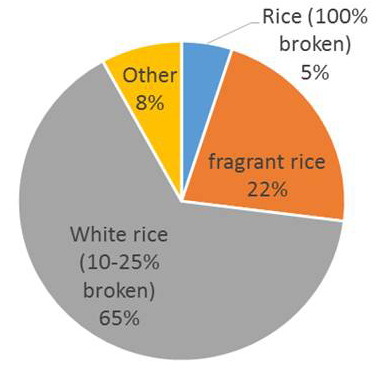
Fig. 2. Export rice types
Source: General Department of Vietnam Customs, 2016
Among all export rice in 2016, 25% broken white rice accounted for only 12% which is much lower than 20% in 2015. Meanwhile, percentage of the 5% broken white rice has increased significantly up to 73%, much higher than 50% in 2015.
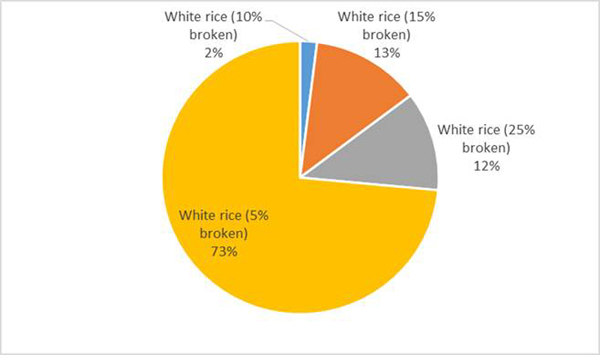
Fig. 3. White rice export by proportion
Source: General Department of Vietnam Customs, 2016
As we can see the quality of Vietnam rice export has been improved thanks to changes of rice varieties and increased export to more premium markets such as USA, Japan and EU.
Export rice by markets
Export markets of Vietnam rice is quality-dependent. For example, high quality rice is usually exported to difficult markets such as Japan and EU, while lower quality rice is exported to Asian markets such as China, Indonesia, Philippine, Malaysia and some countries in Africa.
Japonia rice is a round clammy rice variety due to its low amylose content and amlopectin containing. When cooked, the rice is white, fully rounded like pearls. Japonica rice has many antioxidants, minerals such as Manesium, selinium which help to produce energy from proteins, starches, supporting immune system and mantaining blood glucose level, which is good for people with asthma, low blood pressure and helps lower the risk of heart-related diseases, cancers, hepatitis as well as boosts the process of metabolism, increasing the body resistance, maintaining a healthy nervous system and joints.
Vinaseed is currently constructing a Japonica rice value chain in 10 cities along Red River Delta and the Northern Midlands and Mountains under a joint venture project between Vinaseed and the Netherlands Development Organization (SNV) And Vietnam Business Challenge Fund (VBCF) with the investment capital of over 34 billion VND, attracting farmers’ participation from breeding stage to production and organizing the procurement of commodity, through which the household income has risen between 30% and 60%; Farmers’ skills has also improved, forming villages of agricultural production.
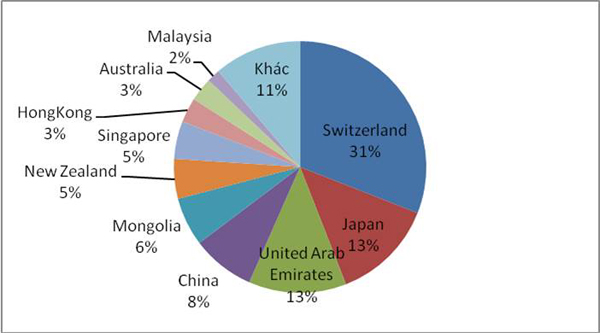
Fig. 4. Destination of Vietnam Japonica export in 2016
Source: General Department of Vietnam Customs, 2016
In recent years,the round Japonica rice type has been exported mainly to Switzerland (31%), Japan (13%) and United Arab Emirates (13%). Therefore, only three countries has imported 60% of Vietnam rice export volume in 2016.
White rice, which is in the Indica long rice group, has been most exported in the last few years. Long white rice is categorized into percentage of broken kernels: white rice with 5%, 10%, 15% and 25% broken kernels. Besides, there is also Jasmine rice with 5% and 10% broken kernels.
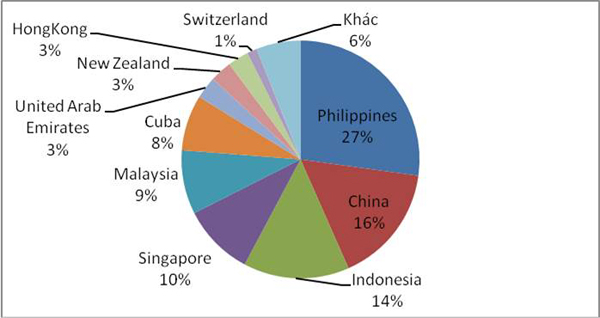
Fig. 5. Destination of Vietnam white rice in 2016
Source: General Department of Vietnam Customs, 2016
As was analyzed above, in 2016, the long white rice was exported mainly to China (16%), the Philippines (27%), and Indonesia (14%). These 3 markets accounted for nearly 60% of total long white rice export volume of Vietnam. Depending on the life standards and consumption habits, the import countries may buy different rice types. However, these markets accept low quality rice and much lower price compared to round rice.
In recent years, the amount of aromatic rice export has significantly grown. Cooked rice is usually clammy with great quality. Protein level in the rice is high. Rice grain is long and small.

Fig. 6. Destination of Vietnam Aromatic export in 2016
Source: General Department of Customs, 2016.
Aromatic rice markets mainly were exported to Singapore (22%), China (18%), and Hongkong (14%). Therefore, the three markets accounted for 54% of the total aromatic rice export in 2016. Malaysia and USA markets has also grown significantly in that year.
Sticky rice is a special rice due to its non-digestive gluten content (meaning no gluttenin and gliadin). Therefore, it is safe for non-gluten diet. Sticky rice is distinguished from other types of rice by having no (or negligible amounts of) amylose, and high amounts of amylopectin. Amylopectin is responsible for the glue-like quality of sticky rice. Sticky rice is cultivated in Bangladesh, China, Janpan, Korea, the Philippines, Thailand, Laos, Indonesia and Vietnam. In Laos, about 85 percent of rice production is sticky rice. Nowadays, higher-yield strains of sticky rice has spread across Laos. More than 70% of the area along the Mekong River Valley were of these newer strains.

Fig. 7. Destination of Vietnam sticky rice export in 2016
Source: General Department of Vietnam Customs, 2016.
Vietnam also has a large sticky rice acreage. Every year, sticky rice exports are worth 900.000 USD, mainly to China (58%), Singapore (24%), Taiwan (5%). The three markets accounted for 87 percent in this rice export volume.
Rice production standards
In previous years, the Ministry of Agriculture and Rural Development (MARD) and the People’s Committees of the Mekong Delta provinces advised rice farmers not to grow IR50404 rice because this variety produce low quality rice. However, famers still cultivated IR50404 type becauseit has high yields and can still be exported. But in fact, the quality of the current 5% broken white rice is decreasing. Most Vietnamese IR50404 rice has chalky dots on the grains, which was previously acceptable to the foreign markets but after a few years, the markets have begun to react to changes of the rice quality, claiming that Vietnam’s rice has become harder.
Rice export rejection
According to the Vietnam Food Association (VFA), only within the first four months of this year, 95 rice containers (equivalent to more than 1,700 tons) were rejected by importers. The rejected rice includes jasmine aromatic rice, Jasmine broken rice, brown rice and high quality white rice.
According to the FDA, from 2012 to August 2016, a total of 16 rice export enterprises in Vietnam to this market have shipments returned back to Vietnam, with a total of 412 containers, equivalent to nearly 10,000 tons of rice and most of them are jasmine aromatic rice, jasmine broken rice, brown rice and high quality white rice.
According to Plant Protection department (Ministry of Agriculture and rural development), actually, nationwide plant quarantine system shows 29 batches of exported rice is rejected by USA. The main reason is due towrong packing process with technical standards of importers or breach of contract. Six in a total of 29 shipments were returned due to pesticide residues. However, this does not mean that all rice exported to the United States did not meet the food safety requirements. Some shipment were rejected by USA because some pesticides in USA do not yet have regulations on the maxium amount of pesticide residue. Therefore, as long as those pesticides are found in the products, no matter how much they are, the shipments has to be returned.
There are many reasons for rejected rice. Firstly, farmers use more fertilizers and pesticides than the allowed levels. Secondly, some enterprises didn’t implement or implemented incorrectly rice production standards such as VietGap, Global GAP.
Besides, in recent years, Vietnam’s rice has been exporting rice mainly to “easy” markets like China and Africa. In countries with high export requirements such as United States, Japan and EU require high quality rice, they even forbid the import of rice containing pesticide and fertilizer residuals.
CONCLUSION
Rice is a major export commodity in Vietnam. Export value of rice is around US$3 billion per year. Vietnam exports rice to many countries in the world, mainly China, Indonesia, Philippine, Malaysia and some Africa countries. Even having a good record in volume, rice export quality of Vietnam is still poor due to:
- Not yet meeting the international standards, such as (1) Grain dimensions (2) Shade of bran (3) Chalkiness ratio (4) Milling quality (5) Rice quality (6) Gelatinization temperature (7) Gel consistency (8) Aroma. Vietnam’s rice has not met most of these elements so the value is lower than that of other countries such as Thailand and India.
- Switching process from low value varieties such as IR50404 to better quality rice such as Japonica, Jasmine 85, OM 4900 takes place slowly. Currently, Vietnam rice is usually exported to easy markets such as China, the Philippines and Indonesia.
- The MARD's rice export standards was issued a long time ago and is no longer appropriate. There is a need for amendment and modification.
- The over-use of chemical fertilizers and pesticides has caused a serious reduction in the rice quality. Specifically, within eight months of 2016, 412 export rice containers were returned mostly due to toxic chemicals.
- Vietgap and other GAP standards for rice production are still limited, making it difficult to apply and should be more closely aligned with international standards such as Global gap.
- Postharvest activities is also poor which further reduced the make quality of rice export.
REFERENCES
Macroeconomic report in 2016, GSO
GSO statistics, https://www.gso.gov.vn/default.aspx?tabid=717
Overview of the rice markte in 2015 and outlook for 2016, AGROINFO
2016 Vietnam rice export quality is poor, why? Journal of industry and commerce 2016.
Bach Duong, alarm rice exports to the United States rejected, Vneconomy, 2016.
|
Date submitted: July 21, 2017
Reviewed, edited and uploaded: July 26, 2016
|


Current Status of Vietnam Rice Export Quality
ABSTRACT
In recent years, although Vietnam rice has ranked 2nd in export in international arena, the rice quality is still low. Majority of rice export is of low quality and without recognized brands, which has led to a lower price in comparison with that of Thailand and India. The main cause is explained by the production habits of farmers in the country. Farmers were encouraged to slowly change from low-quality varieties to better ones, butlow-productive varieties as IR50404 are still in large proportion. Beside, the export standards which were issued long time ago, are now no longer suitable. Using too much pesticides in cultivation also makes Vietnam rice difficult to reach premium markets as USA and Japan. For example: in 2016, many shipments to the United States were rejected and returned because of chemical contamination.
Vietnam rice export quality
According to the Ministry of Agriculture and Rural Development, in 2016, the total rice export was about 4.54 million tons, equivalent to US$2 billion, down 25% in volume and 20.3% in value in comparison with those of 2015. The main difficulties came from the fact that China has tightened the control over rice exports and imports across the northern borders.
Fig. 1. Changes in rice export value from 2009 to 2016
Source: General department of Vietnam Customs
Export rice by types
In 2016, major types of rice export were white rice with 5%-25% broken rate (accounted for 70% of total export volume). Aromatic rice accounted for a quarter of total export rice volume, including Jasmine 85, SocTrang, Nang Hoa, Huong Lai, KDM, VD 20. Among the aromatic rice varieties, Jasmine was the largest product.
In 2016, 25% broken rice has decreased significantly, accounting for only 5% in total rice export, and the export proportion of 25% broken white rice has increased in comparison with that of 2015, reaching 16% in total export share. The proportion of sticky rice was little and mostly exported to China market at the end of the year.
Fig. 2. Export rice types
Source: General Department of Vietnam Customs, 2016
Among all export rice in 2016, 25% broken white rice accounted for only 12% which is much lower than 20% in 2015. Meanwhile, percentage of the 5% broken white rice has increased significantly up to 73%, much higher than 50% in 2015.
Fig. 3. White rice export by proportion
Source: General Department of Vietnam Customs, 2016
As we can see the quality of Vietnam rice export has been improved thanks to changes of rice varieties and increased export to more premium markets such as USA, Japan and EU.
Export rice by markets
Export markets of Vietnam rice is quality-dependent. For example, high quality rice is usually exported to difficult markets such as Japan and EU, while lower quality rice is exported to Asian markets such as China, Indonesia, Philippine, Malaysia and some countries in Africa.
Japonia rice is a round clammy rice variety due to its low amylose content and amlopectin containing. When cooked, the rice is white, fully rounded like pearls. Japonica rice has many antioxidants, minerals such as Manesium, selinium which help to produce energy from proteins, starches, supporting immune system and mantaining blood glucose level, which is good for people with asthma, low blood pressure and helps lower the risk of heart-related diseases, cancers, hepatitis as well as boosts the process of metabolism, increasing the body resistance, maintaining a healthy nervous system and joints.
Vinaseed is currently constructing a Japonica rice value chain in 10 cities along Red River Delta and the Northern Midlands and Mountains under a joint venture project between Vinaseed and the Netherlands Development Organization (SNV) And Vietnam Business Challenge Fund (VBCF) with the investment capital of over 34 billion VND, attracting farmers’ participation from breeding stage to production and organizing the procurement of commodity, through which the household income has risen between 30% and 60%; Farmers’ skills has also improved, forming villages of agricultural production.
Fig. 4. Destination of Vietnam Japonica export in 2016
Source: General Department of Vietnam Customs, 2016
In recent years,the round Japonica rice type has been exported mainly to Switzerland (31%), Japan (13%) and United Arab Emirates (13%). Therefore, only three countries has imported 60% of Vietnam rice export volume in 2016.
White rice, which is in the Indica long rice group, has been most exported in the last few years. Long white rice is categorized into percentage of broken kernels: white rice with 5%, 10%, 15% and 25% broken kernels. Besides, there is also Jasmine rice with 5% and 10% broken kernels.
Fig. 5. Destination of Vietnam white rice in 2016
Source: General Department of Vietnam Customs, 2016
As was analyzed above, in 2016, the long white rice was exported mainly to China (16%), the Philippines (27%), and Indonesia (14%). These 3 markets accounted for nearly 60% of total long white rice export volume of Vietnam. Depending on the life standards and consumption habits, the import countries may buy different rice types. However, these markets accept low quality rice and much lower price compared to round rice.
In recent years, the amount of aromatic rice export has significantly grown. Cooked rice is usually clammy with great quality. Protein level in the rice is high. Rice grain is long and small.
Fig. 6. Destination of Vietnam Aromatic export in 2016
Source: General Department of Customs, 2016.
Aromatic rice markets mainly were exported to Singapore (22%), China (18%), and Hongkong (14%). Therefore, the three markets accounted for 54% of the total aromatic rice export in 2016. Malaysia and USA markets has also grown significantly in that year.
Sticky rice is a special rice due to its non-digestive gluten content (meaning no gluttenin and gliadin). Therefore, it is safe for non-gluten diet. Sticky rice is distinguished from other types of rice by having no (or negligible amounts of) amylose, and high amounts of amylopectin. Amylopectin is responsible for the glue-like quality of sticky rice. Sticky rice is cultivated in Bangladesh, China, Janpan, Korea, the Philippines, Thailand, Laos, Indonesia and Vietnam. In Laos, about 85 percent of rice production is sticky rice. Nowadays, higher-yield strains of sticky rice has spread across Laos. More than 70% of the area along the Mekong River Valley were of these newer strains.
Fig. 7. Destination of Vietnam sticky rice export in 2016
Source: General Department of Vietnam Customs, 2016.
Vietnam also has a large sticky rice acreage. Every year, sticky rice exports are worth 900.000 USD, mainly to China (58%), Singapore (24%), Taiwan (5%). The three markets accounted for 87 percent in this rice export volume.
Rice production standards
In previous years, the Ministry of Agriculture and Rural Development (MARD) and the People’s Committees of the Mekong Delta provinces advised rice farmers not to grow IR50404 rice because this variety produce low quality rice. However, famers still cultivated IR50404 type becauseit has high yields and can still be exported. But in fact, the quality of the current 5% broken white rice is decreasing. Most Vietnamese IR50404 rice has chalky dots on the grains, which was previously acceptable to the foreign markets but after a few years, the markets have begun to react to changes of the rice quality, claiming that Vietnam’s rice has become harder.
Rice export rejection
According to the Vietnam Food Association (VFA), only within the first four months of this year, 95 rice containers (equivalent to more than 1,700 tons) were rejected by importers. The rejected rice includes jasmine aromatic rice, Jasmine broken rice, brown rice and high quality white rice.
According to the FDA, from 2012 to August 2016, a total of 16 rice export enterprises in Vietnam to this market have shipments returned back to Vietnam, with a total of 412 containers, equivalent to nearly 10,000 tons of rice and most of them are jasmine aromatic rice, jasmine broken rice, brown rice and high quality white rice.
According to Plant Protection department (Ministry of Agriculture and rural development), actually, nationwide plant quarantine system shows 29 batches of exported rice is rejected by USA. The main reason is due towrong packing process with technical standards of importers or breach of contract. Six in a total of 29 shipments were returned due to pesticide residues. However, this does not mean that all rice exported to the United States did not meet the food safety requirements. Some shipment were rejected by USA because some pesticides in USA do not yet have regulations on the maxium amount of pesticide residue. Therefore, as long as those pesticides are found in the products, no matter how much they are, the shipments has to be returned.
There are many reasons for rejected rice. Firstly, farmers use more fertilizers and pesticides than the allowed levels. Secondly, some enterprises didn’t implement or implemented incorrectly rice production standards such as VietGap, Global GAP.
Besides, in recent years, Vietnam’s rice has been exporting rice mainly to “easy” markets like China and Africa. In countries with high export requirements such as United States, Japan and EU require high quality rice, they even forbid the import of rice containing pesticide and fertilizer residuals.
CONCLUSION
Rice is a major export commodity in Vietnam. Export value of rice is around US$3 billion per year. Vietnam exports rice to many countries in the world, mainly China, Indonesia, Philippine, Malaysia and some Africa countries. Even having a good record in volume, rice export quality of Vietnam is still poor due to:
REFERENCES
Macroeconomic report in 2016, GSO
GSO statistics, https://www.gso.gov.vn/default.aspx?tabid=717
Overview of the rice markte in 2015 and outlook for 2016, AGROINFO
2016 Vietnam rice export quality is poor, why? Journal of industry and commerce 2016.
Bach Duong, alarm rice exports to the United States rejected, Vneconomy, 2016.
Date submitted: July 21, 2017
Reviewed, edited and uploaded: July 26, 2016